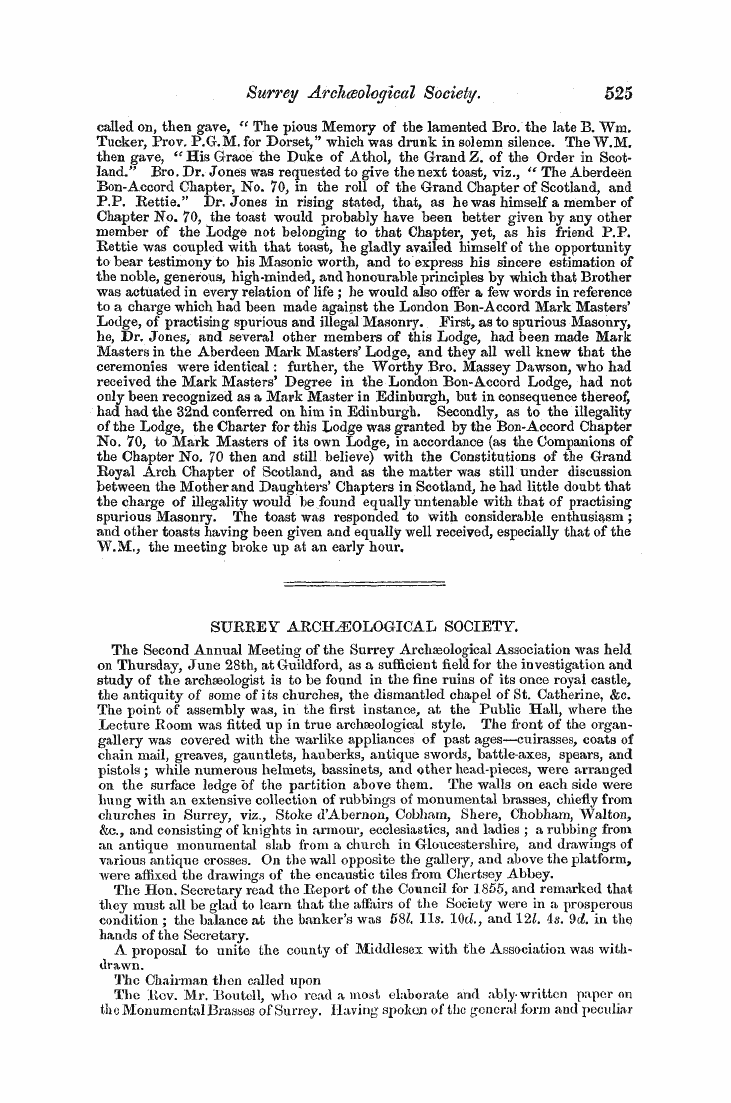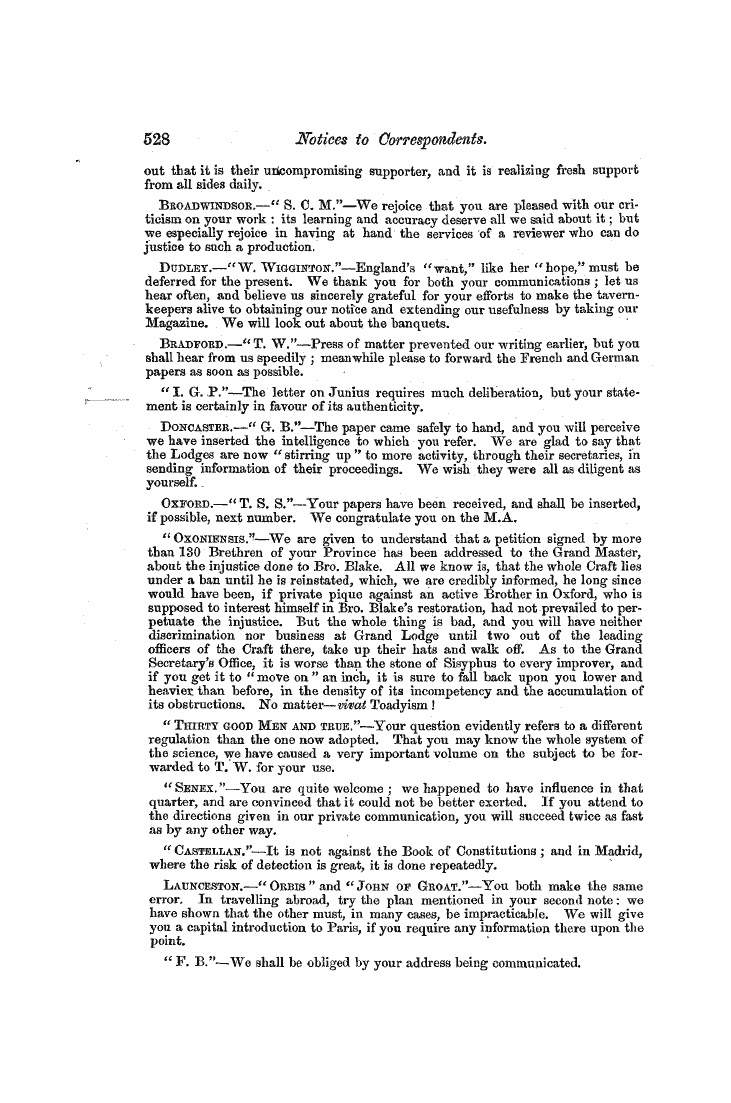-
Articles/Ads
Article Untitled Article ← Page 2 of 2
Note: This text has been automatically extracted via Optical Character Recognition (OCR) software.
Untitled Article
characteristics of all the varieties of monumental brasses extant , and their extensive prevalence in Belgium and Germany , Mr . Boutell remarked that the earliest example of a brass , of which we had any record , was in the church of St . Paul , at Bedford , to Earl Simon de Beaucamp , who died before A . D . 1200 . This
memorial , now long lost , consisted of a border inscription with , probably , a cross . The earliest brass of which the design had been preserved ( by means of an engraving ) was in France , and commemorated Philip and John , the two sons of Louis YIIL , who reigned from A . D . 1223 to 1226 ; and the earliest brass known to be still in existence Was the bold and martial effigy of Sir John D'Aubernon , in the church of Stoke D'Abernon , in the county of Surrey .
The company then left the Public Hall , and proceeded on a visit to Guildford Castle . Taking his stand on the green area on the west side of the ruined keep * Mr . Godwin-Austen gave an eloquent and clear description of the principal characteristics of the building . Pointing out the features in the exterior of the building most deserving of attention , the speaker referred to the herring-bone work , which was in itself proof of the antiquity of the structure . At the period when this arrangement was adopted , the thick walls , instead of being built solid , were formed of a casing on each side , the interval being filled up with grouting .
If the building proceeded rapidly , a great pressure would be caused on the outer casing , and it was thought by arranging the work in this herring-bone form it would afford additional strength , and form a greater bond to the mass . Describing the " fern-leaf" arch and other peculiarities , Mr . Godwin-Austen stated that the building , from its general indications , was referable to a period embraced within the 6 th and 11 th centuries . He compared some of the details of this ruin
with the castle at Rochester , and stated that the small open windows corresponded with some of those in the Tower of London , adding a summary of the reasons for concluding that the castle was built in the Heptarchy , and , as such , was one of the most interesting ruins now remaining in England . The party might have noticed , in ascending the mound , that a portion of one of the walls was in a state of preservation far superior to the remainder . That was a restoration by the late Duke of Norfolk , at the time he owned the castle .
After visiting some of the ruined precincts of the ancient castle , the party proceeded on a visit to St . Mary Church , the peculiarities of which , with its remarkable apse , were pointed out by the Rev . Mr . Boutell . The interior of the church was described at very full length . He spoke of the different divisions and eras of architecture , and showed their application to this church , which he presented to the notice of young archaeologists as one well worthy of their study . The church
itself was undoubtedly of Anglo-Norman origin , at which era its dimensions were exceedingly circumscribed . As the population increased , it was no doubt found that the space was too limited , and it was enlarged on several subsequent occasions , and the Early English Gothic , and the Early Decorative Gothic , & c , were grafted on the original building .
bhortly before six o ' clock , a company numbering about 160 ladies and gentlemen sat down to dinner at the White Hart Hotel , under the presidency of W . J . Evelyn , Esq ., M . P ., supported by the Earl of Lovelace , and other distinguished persons connected with the county . The efficient band of the Surrey Militia , of which the noble earl is colonel , was stationed in the antechamber , and performed several popular pieces .
The proceedings at the table terminated , and the company adjourned to a Conversazione , which was appointed to be held at the Public Hall—the band also moving their quarters to the same point of gathering . The objects submitted to the notice of those present were of the most interesting character . About ten o ' clock the band played the National Anthem , and the Hall was soon cleared of the busy throng who had passed an agreeable evening within its walls .
Note: This text has been automatically extracted via Optical Character Recognition (OCR) software.
Untitled Article
characteristics of all the varieties of monumental brasses extant , and their extensive prevalence in Belgium and Germany , Mr . Boutell remarked that the earliest example of a brass , of which we had any record , was in the church of St . Paul , at Bedford , to Earl Simon de Beaucamp , who died before A . D . 1200 . This
memorial , now long lost , consisted of a border inscription with , probably , a cross . The earliest brass of which the design had been preserved ( by means of an engraving ) was in France , and commemorated Philip and John , the two sons of Louis YIIL , who reigned from A . D . 1223 to 1226 ; and the earliest brass known to be still in existence Was the bold and martial effigy of Sir John D'Aubernon , in the church of Stoke D'Abernon , in the county of Surrey .
The company then left the Public Hall , and proceeded on a visit to Guildford Castle . Taking his stand on the green area on the west side of the ruined keep * Mr . Godwin-Austen gave an eloquent and clear description of the principal characteristics of the building . Pointing out the features in the exterior of the building most deserving of attention , the speaker referred to the herring-bone work , which was in itself proof of the antiquity of the structure . At the period when this arrangement was adopted , the thick walls , instead of being built solid , were formed of a casing on each side , the interval being filled up with grouting .
If the building proceeded rapidly , a great pressure would be caused on the outer casing , and it was thought by arranging the work in this herring-bone form it would afford additional strength , and form a greater bond to the mass . Describing the " fern-leaf" arch and other peculiarities , Mr . Godwin-Austen stated that the building , from its general indications , was referable to a period embraced within the 6 th and 11 th centuries . He compared some of the details of this ruin
with the castle at Rochester , and stated that the small open windows corresponded with some of those in the Tower of London , adding a summary of the reasons for concluding that the castle was built in the Heptarchy , and , as such , was one of the most interesting ruins now remaining in England . The party might have noticed , in ascending the mound , that a portion of one of the walls was in a state of preservation far superior to the remainder . That was a restoration by the late Duke of Norfolk , at the time he owned the castle .
After visiting some of the ruined precincts of the ancient castle , the party proceeded on a visit to St . Mary Church , the peculiarities of which , with its remarkable apse , were pointed out by the Rev . Mr . Boutell . The interior of the church was described at very full length . He spoke of the different divisions and eras of architecture , and showed their application to this church , which he presented to the notice of young archaeologists as one well worthy of their study . The church
itself was undoubtedly of Anglo-Norman origin , at which era its dimensions were exceedingly circumscribed . As the population increased , it was no doubt found that the space was too limited , and it was enlarged on several subsequent occasions , and the Early English Gothic , and the Early Decorative Gothic , & c , were grafted on the original building .
bhortly before six o ' clock , a company numbering about 160 ladies and gentlemen sat down to dinner at the White Hart Hotel , under the presidency of W . J . Evelyn , Esq ., M . P ., supported by the Earl of Lovelace , and other distinguished persons connected with the county . The efficient band of the Surrey Militia , of which the noble earl is colonel , was stationed in the antechamber , and performed several popular pieces .
The proceedings at the table terminated , and the company adjourned to a Conversazione , which was appointed to be held at the Public Hall—the band also moving their quarters to the same point of gathering . The objects submitted to the notice of those present were of the most interesting character . About ten o ' clock the band played the National Anthem , and the Hall was soon cleared of the busy throng who had passed an agreeable evening within its walls .































































